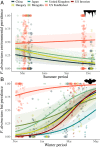Environmental reservoir dynamics predict global infection patterns and population impacts for the fungal disease white-nose syndrome
- PMID: 32179668
- PMCID: PMC7132137
- DOI: 10.1073/pnas.1914794117
Environmental reservoir dynamics predict global infection patterns and population impacts for the fungal disease white-nose syndrome
Abstract
Disease outbreaks and pathogen introductions can have significant effects on host populations, and the ability of pathogens to persist in the environment can exacerbate disease impacts by fueling sustained transmission, seasonal epidemics, and repeated spillover events. While theory suggests that the presence of an environmental reservoir increases the risk of host declines and threat of extinction, the influence of reservoir dynamics on transmission and population impacts remains poorly described. Here we show that the extent of the environmental reservoir explains broad patterns of host infection and the severity of disease impacts of a virulent pathogen. We examined reservoir and host infection dynamics and the resulting impacts of Pseudogymnoascus destructans, the fungal pathogen that causes white-nose syndrome, in 39 species of bats at 101 sites across the globe. Lower levels of pathogen in the environment consistently corresponded to delayed infection of hosts, fewer and less severe infections, and reduced population impacts. In contrast, an extensive and persistent environmental reservoir led to early and widespread infections and severe population declines. These results suggest that continental differences in the persistence or decay of P. destructans in the environment altered infection patterns in bats and influenced whether host populations were stable or experienced severe declines from this disease. Quantifying the impact of the environmental reservoir on disease dynamics can provide specific targets for reducing pathogen levels in the environment to prevent or control future epidemics.
Keywords: Pseudogymnoascus destructans; environmental pathogen reservoir; global disease dynamics; white-nose syndrome.
Copyright © 2020 the Author(s). Published by PNAS.
Conflict of interest statement
The authors declare no competing interest.
Figures





References
-
- Daszak P., Cunningham A. A., Hyatt A. D., Emerging infectious diseases of wildlife—Threats to biodiversity and human health. Science 287, 443–449 (2000). - PubMed
-
- Frick W. F., et al. , Disease alters macroecological patterns of North American bats. Glob. Ecol. Biogeogr. 24, 741–749 (2015).
-
- Scheele B. C., et al. , Amphibian fungal panzootic causes catastrophic and ongoing loss of biodiversity. Science 363, 1459–1463 (2019). - PubMed

